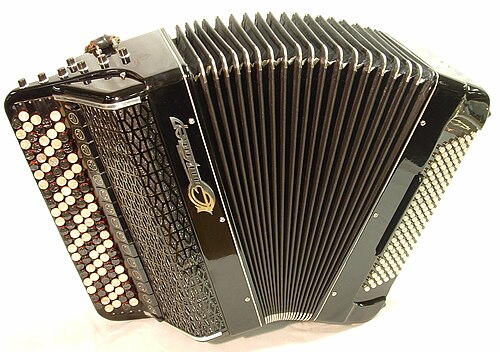 | |
| Classification | Free-reed aerophone |
|---|---|
| Hornbostel–Sachs classification | 412.132 |
| Playing range | |
Right-hand manual:The Russian bayan andchromatic button accordions have a much greater right-hand range inscientific pitch notation than accordions with a piano keyboard: five octaves, plus a minor third (written range = E2-G7, actual range = E1-C#8).[1] Left-hand manual | |
| Musicians | |
| List of accordionists | |
| More articles or information | |
| Accordion,chromatic button accordion,diatonic button accordion,piano accordion,stradella bass system,free-bass system,accordion reed ranks and switches | |
Thebayan (Russian:бая́н,IPA:[bɐˈjan]) is a type ofchromatic button accordion developed in theRussian Empire in the early 20th century and named after the 11th-centurybardBoyan.[2]


The bayan differs from western chromatic button accordions in some details of construction:
The differences in internal construction give the bayan a differenttone color from Western instruments, and thebass has a much fuller sound. Because of their range and purity of tone, bayans are often the instrument of choice for accordion virtuosi who performclassical andcontemporary classical music. Two Soviet composers of note who wrote compositions for bayan areVladislav Zolotaryov andSofia Gubaidulina. Slovak composerPeter Machajdík composedConcerto for Two Bayans and Orchestra,[3] which was premiered by Acco Duo (Miran Vaupotić & Ivana Levak-Vaupotić), with the Symphony Orchestra of the Pomeranian Philharmonic under Alexander Gref, at the Paderewski Philharmonic in Bydgoszcz, Poland on 4 June 2009. Russian Bayan virtuoso Stas Venglevski has premiered contemporary works byYehuda Yannay,Anthony Galla-Rini andWilliam Susman.[4]